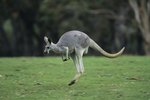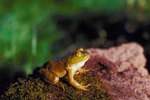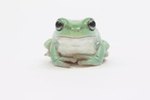Both frogs and humans have intricate muscular systems, but a close inspection reveals that they are built in ways particular to the needs of each. Simply put, frogs are built for jumping and humans are built to do many things.
Skeleton
Muscles in both frogs and humans adhere to a skeleton. Although the striated muscles (muscles for movement) connect with muscle fibers and tissues in both species, the number and types of bones effect specialized movement. For example, humans have 24 vertebrae that allow for back arching movements, while frogs have only nine. A frog's combined tibiofibula, or large shin bone, makes jumping much easier compared to the separate shin bones in humans.
Specialized Skills
Frogs have one main skill: jumping. Humans, due to a greater bone count and more extensive muscular system, have several abilities, including, running, jumping, walking, climbing, swimming, sitting, standing upright, slouching and squatting.
Diaphragm
Frogs lack one thing that humans have and use every second: a diaphragm. This muscle in humans helps with the involuntary motion of breathing. Frogs move oxygen in and out of their skin.
Bipeds vs. Quadrupeds
Humans are bipeds, meaning they walk upright on two legs, while frogs must walk and hop using all four of their legs. Our advanced muscle system allows us to stand without wobbling or toppling.
Jaw Muscles
Unlike humans, toads have an extensive muscle system within their jaws. These muscles help in the gathering and consuming of food, as they work to thrust the tongue outward to catch prey.
Throat Muscles
When eating or drinking, the throat muscles of a human push the food down the esophagus, starting the process of digestion. Frogs drink by absorbing water and moisture through their thin-layered skin and use muscles in their eye cavities to push the food down their throats for digestion.
Chest Muscles
Chest muscles aid in the involuntary breathing patterns of humans. Frogs have sac-like lungs that require no chest muscle aid, thus they lack chest muscles.





